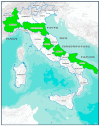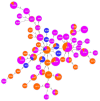Prevalence, Population Diversity and Antimicrobial Resistance of Campylobacter coli Isolated in Italian Swine at Slaughterhouse
- PMID: 32046038
- PMCID: PMC7074678
- DOI: 10.3390/microorganisms8020222
Prevalence, Population Diversity and Antimicrobial Resistance of Campylobacter coli Isolated in Italian Swine at Slaughterhouse
Abstract
Campylobacter spp. are among the microorganisms most commonly associated with foodborne disease. Swine are known to be the main reservoir of Campylobacter coli and a possible source infection of humans as a result of carcass contamination at slaughter. The aim of this study was to evaluate the prevalence of C. coli contamination in swine carcasses, the antimicrobial resistance (AMR) patterns of isolates and the genetic diversity between strains obtained from swine and those isolated from humans. The prevalence of contamination was higher on carcasses (50.4%) than in faeces (32.9%). The 162 C. coli isolated from swine were examined by pulsed-field gel electrophoresis (PFGE) and multi-locus sequence typing (MLST). The results of PFGE indicated a high genetic diversity among the isolates, with 25 different PFGE types. MLST assigned 51 sequence types (STs) to isolates. The most common genotype was ST-854 (16.04%), ST-9264 (10.49 %) and ST-1016 (6.08 %). Results of AMR showed a high resistance to quinolones and fluoroquinolones together with aminoglycosides and tetracycline. Many strains were multi-resistant with predominant R-type TeSCipNa (57%). Five resistance genes were detected along with mutation in the gyrA gene. A strong correlation between phenotypic and genotypic resistance was found for fluoroquinolone and tetracycline. Genetic profiles obtained in swine isolates were compared to those of 11 human strains. All human strains and 64.19% of animal strains (104/162) were assigned to the ST-828 clonal complex.
Keywords: Campylobacter coli; antimicrobial resistance; molecular analysis.
Conflict of interest statement
The authors declare no conflicts of interest.
Figures




Similar articles
-
Genotyping and Antibiotic Resistance Traits in Campylobacter jejuni and coli From Pigs and Wild Boars in Italy.Front Cell Infect Microbiol. 2020 Oct 15;10:592512. doi: 10.3389/fcimb.2020.592512. eCollection 2020. Front Cell Infect Microbiol. 2020. PMID: 33178635 Free PMC article.
-
Phylogenetic Diversity and Antimicrobial Resistance of Campylobacter coli from Humans and Animals in Japan.Microbes Environ. 2019 Jun 27;34(2):146-154. doi: 10.1264/jsme2.ME18115. Epub 2019 Mar 21. Microbes Environ. 2019. PMID: 30905895 Free PMC article.
-
Campylobacter coli in swine production: antimicrobial resistance mechanisms and molecular epidemiology.J Clin Microbiol. 2005 Nov;43(11):5705-14. doi: 10.1128/JCM.43.11.5705-5714.2005. J Clin Microbiol. 2005. PMID: 16272508 Free PMC article.
-
Antimicrobial susceptibility, pulsed-field gel electrophoresis, and multi-locus sequence typing of Campylobacter coli in swine before, during, and after the slaughter process.Foodborne Pathog Dis. 2012 Jun;9(6):506-12. doi: 10.1089/fpd.2011.1053. Foodborne Pathog Dis. 2012. PMID: 22663186
-
Tracking Campylobacter contamination along a broiler chicken production chain from the farm level to retail in China.Int J Food Microbiol. 2014 Jul 2;181:77-84. doi: 10.1016/j.ijfoodmicro.2014.04.023. Epub 2014 Apr 28. Int J Food Microbiol. 2014. PMID: 24831929
Cited by
-
Molecular characterization of Campylobacter spp. recovered from beef, chicken, lamb and pork products at retail in Australia.PLoS One. 2020 Jul 30;15(7):e0236889. doi: 10.1371/journal.pone.0236889. eCollection 2020. PLoS One. 2020. PMID: 32730330 Free PMC article.
-
Genotyping and Antibiotic Resistance Traits in Campylobacter jejuni and coli From Pigs and Wild Boars in Italy.Front Cell Infect Microbiol. 2020 Oct 15;10:592512. doi: 10.3389/fcimb.2020.592512. eCollection 2020. Front Cell Infect Microbiol. 2020. PMID: 33178635 Free PMC article.
-
Editorial: Campylobacter-associated food safety.Front Microbiol. 2022 Oct 26;13:1038128. doi: 10.3389/fmicb.2022.1038128. eCollection 2022. Front Microbiol. 2022. PMID: 36386703 Free PMC article. No abstract available.
-
Prevalence and antimicrobial resistance of Campylobacter and Salmonella in layer flocks in Honshu, Japan.J Vet Med Sci. 2022 Nov 7;84(11):1502-1507. doi: 10.1292/jvms.22-0257. Epub 2022 Oct 4. J Vet Med Sci. 2022. PMID: 36198611 Free PMC article.
-
Comparative Analysis of Campylobacter jejuni and C. coli Isolated from Livestock Animals to C. jejuni and C. coli Isolated from Surface Water Using DNA Sequencing and MALDI-TOF.Pathogens. 2023 Aug 22;12(9):1069. doi: 10.3390/pathogens12091069. Pathogens. 2023. PMID: 37764877 Free PMC article.
References
-
- Jacobs-Reitsma W. Campylobacter in the food supply. In: Nachamkin I., Blaser M.J., editors. Campylobacter. 2nd ed. ASM Press; Washington, DC, USA: 2000. pp. 467–481.
Grants and funding
LinkOut - more resources
Full Text Sources
Molecular Biology Databases
Miscellaneous

